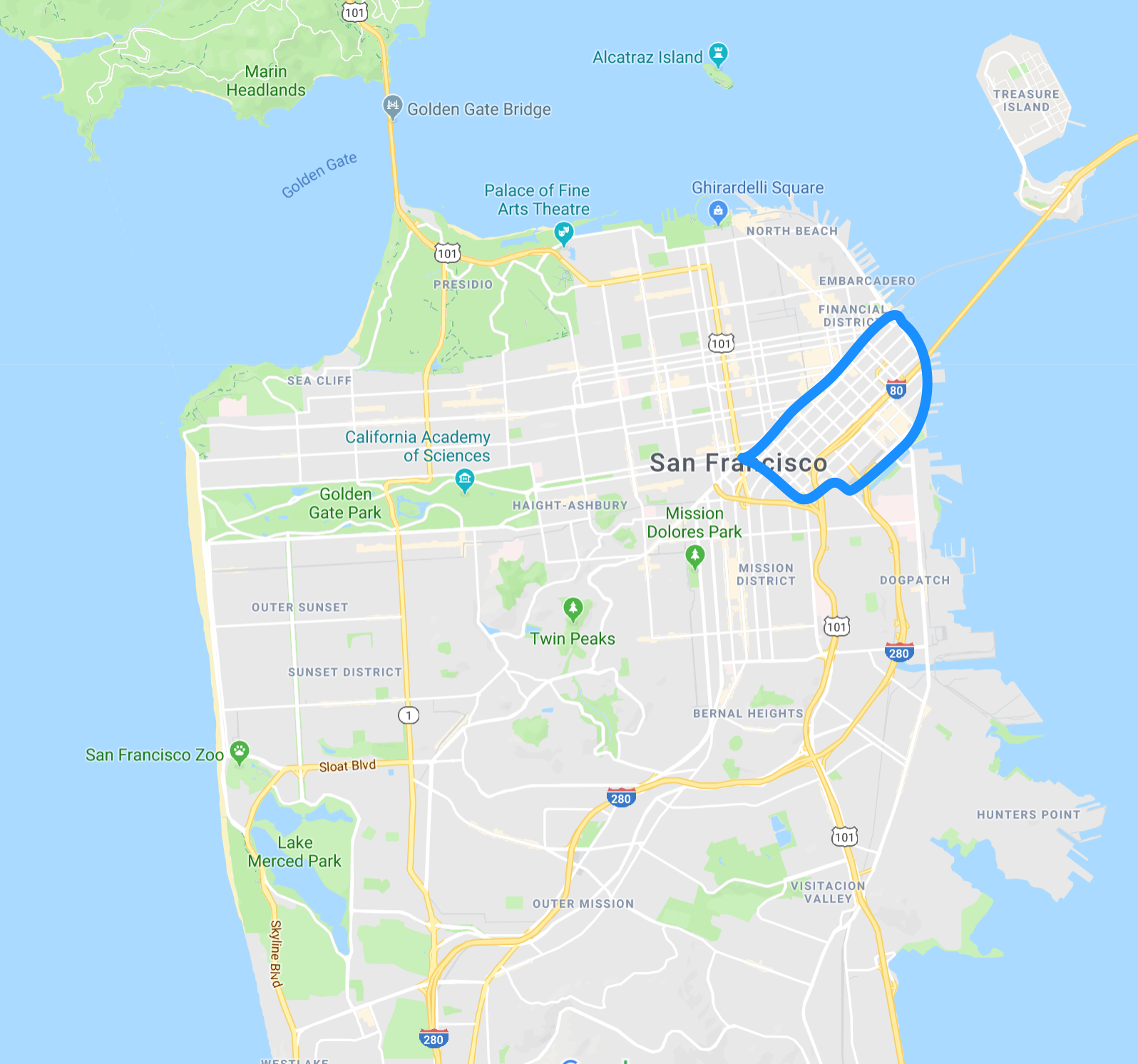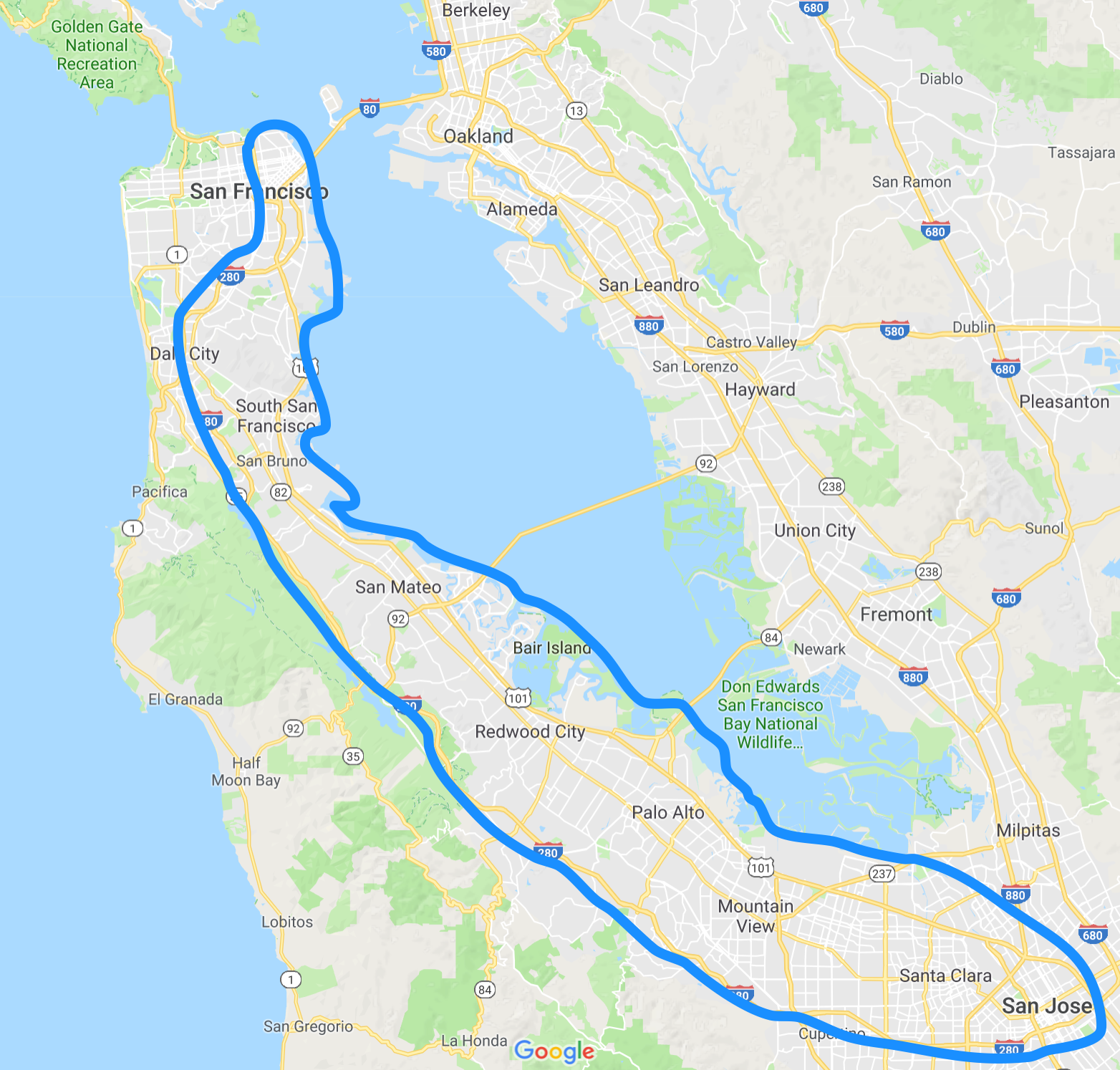A startup jobseeker’s guide for moving to San Francisco
America is losing its dynamism and succumbing to complacency. At least, that’s the argument Tyler Cowen makes in The Complacent Class...

America is losing its dynamism and succumbing to complacency. At least, that’s the argument Tyler Cowen makes in The Complacent Class. Citing the plummeting rate of Americans migrating across state lines (down 51% since mid-last-century) and the falling share of Americans under 30 who own a business (down 65% since the 1980s), Cowen paints a concerning picture for anyone who values American dynamism.
While these trends are troubling for the country as a whole, they should particularly alarm tech industry hubs like San Francisco. To continue its reign as the world’s most innovative place, this region requires a constant stream of talent. If smart motivated people don’t move here, where they can share ideas, best practices, and capital, many great companies may never be formed.
What’s causing Americans to stay put instead of moving to regions with more economic opportunity? One heavily publicized explanation is the shortage of housing and resulting high cost of living in San Francisco. Fueled by depressing headlines about the median cost of a one bedroom or a $20 cup of coffee it’s easy to see why even the most ambitious people get discouraged from moving here.
Headlines like these do people a disservice because important context isn’t included. The only reason landlords can charge expensive rent is that Bay Area tech companies pay well enough to create demand. Also left out of these median rental calculations are the many rooms in rent-controlled apartments listed on sites like Craigslist. Movers who can find cheap places to live during a career transition often end up earning enough to move into apartments that cost significantly more (and still have money left over for bougie coffee shops).
In my role at Tradecraft, I’ve witnessed dozens of people make this transition. Some certainly had help from parents or a nest egg from their previous career. But just as many didn’t have those advantages. I’ve seen people employ scrappy strategies to extend their runway long enough to build an in-demand skillset and earn a much higher salary.
This post is for those who want to break into the Silicon Valley startup scene but need a bit of help navigating the particulars of the transition. I’ll give you my best tips for budgeting your time and money so you can have the best shot at building an amazing career in the startup capital of the world.
Why move to San Francisco?
In a world of remote work and other growing startup hubs, is it worthwhile to move to an expensive city like SF?
Before giving my answer, I’ll admit I’m biased. I was lucky to have been born in San Francisco. I’ve been blessed with family that’s helped me get settled here. Like any 30 year relationship with a place, I’ve seen this city’s flaws and also what makes it truly special. I hope to call this place home for as long as I can.
With that said, I don’t think everyone who wants to work in tech needs to be here. But I do believe that if you want to be world class at what you do, whether that be building products, acquiring customers, or creating companies, there’s no better place to start your career. Just like the best traders learn in New York or the best filmmakers learn in Los Angeles, the Bay Area is the best place to build your skills in tech.
If you’re one of these ambitious people, it’s worth moving here as early in your career as possible. Learning compounds, and the more skill you gain early on, the more smart people and lucrative opportunities you’ll be able to attract. I’ve seen this flywheel allow people to climb the socio-economic ladder very rapidly (as well as get plenty of other non-monetary benefits).



Extending your runway is the name of the game
To make it through a career transition you need to buy yourself time. Your runway measures how long you can pay your bills until your bank account hits zero. Runway matters because, at the beginning of your job search, you’re going to make lots of mistakes. You’ll apply for the wrong roles, you’ll use awkward outreach tactics and you won’t be able to tell hiring managers a compelling story. Over time, as you interview, you’ll refine your tactics and figure out what works. The problem is, it’s hard to know how long it will take to get better at interviewing. If you don’t have enough runway, you may start figuring things out just as stress about time and money takes over.
To calculate your runway, you first need to know how much cash you’re burning through each month. Here’s the formula:

If your cost of living is $2,000/month and you’re making $600/month doing contract work, your monthly burn is $1,400. Once you know your monthly burn, the calculation for runway is easy:

Say you started out with $7,000 in the bank and you manage to keep your monthly burn at $1,400. Then you have five months of runway. From these equations, there are three obvious ways to extend your runway during a job transition:
- Build a bigger nest egg
- Lower your monthly expenses
- Generate more income
Here are some levers you can pull for each of these runway components.
Build a bigger nest egg
The more liquidity you build before the move, the less time you’ll need to spend managing your monthly burn. That’s time and money you can use to build skills and relationships. Here are a few ways to build a bigger nest egg:
Lower your expenses before the move
Take an inventory of your personal spending for the past 2–3 months. Are there meaningful line items you could be saving money on? Save on rent by crashing with family or friends. Buy groceries instead of eating out. Getting in the habit of saving money before you move will put you in the right mindset for lowering your expenses once you’ve relocated.
Sell your stuff
Instead of taking all your belongings, use the move to declutter your life. Furniture, TVs and sports equipment are expensive to ship and will likely be less useful than an extra month of runway. One benefit of living in a city is that you don’t need to own a car to get around. If you’ve got a vehicle sitting in your garage, consider trading it in for cash.
Get a loan from family members
If you need a loan, consider asking family members who can afford it. People in your social networks will often offer you the best rates and the most lenient payback periods (which can come in handy if your job search takes longer than expected). There’s no shame in getting help early in your career. Particularly if you plan to pay the loan back with some interest, the investment will be well worth it to your lender.
Lower Your Monthly Expenses
There’s plenty of advice on the internet for lowering your expenses. So, I’ll stick to tips that are specific to living in San Francisco. While there are lots of ways to spend money here, I’ll cover the ones that make the biggest difference:
Housing
Rent in San Francisco is expensive. As of June 2018 the median asking rent for a 1-bedroom apartment in SF was almost $3,500. Spending that much on rent will significantly shorten your runway. Fortunately you don’t need to be paying exorbitantly high prices to get a roof over your head in SF.
The first step to cutting living expenses is to get roommates. According to the same rental report by Zumper, going in on a two bedroom with one roommate brings down the median cost per room from $3,500 to $2,300. The more roommates you can gather, the more you can save.
To find the best deals in the city look for vacant rooms in apartments with existing tenants. According to an analysis of 5 months of Craigslist data, you can save up to 40% by renting a room in a rented apartment vs. an entirely new apartment. The analysis shows that for room rentals “most neighborhoods have average prices less than $1800” with a considerable number of options in the low $1,000s. You may want to look on Craigslist for a temporary sublet so you can have flexibility to move once you land a job (there are also Facebook groups to help you find free rooms).
If you still can’t find something in your budget range, look for rentals outside of the city near major public transit lines. Living near a BART or Caltrain station means you’ll be able to get to a meeting in SoMa relatively quickly without needing to own a car. My two recommendations for location are:
- Make sure you live no more than an hour commute from the SoMa neighborhood in SF (since this is where you’re likely to have most of your meetings). You can figure this out by plugging potential addresses into Google Maps. Added bonus if you can also be within an hour commute of Silicon Valley (where larger tech companies like Google and Facebook are headquartered).
- Avoid signing a long term lease in the Tenderloin or around 6th and Market. While it has cheap rent, it’s a dangerous and unpleasant place to walk at night.


It can be challenging to search for housing before you move and can see places in person. If possible, find a friend’s couch to crash on for the first two weeks. If you don’t know anyone you can live with, treat yourself to a week in a relatively inexpensive Airbnb that’s close enough to the city to launch a full-time apartment search.
It’s worth putting in the effort to find a good deal on housing as it will be, by far, the largest factor effecting your monthly burn.
Transportation
Between monthly parking, street parking, gas, and the inevitable parking tickets you’ll collect, the costs of owning a car in city can add up quickly. Unless you’ve found an inexpensive living set up that’s far from public transportation, try moving without a car.
To get around the city you have a few options:
- Walk or Bike — SF is more compact than most cities. If you live East of Van Ness Ave. and North of 24th St. it’s quite possible to walk most places you need to go in under an hour (or by bike in under 30 mins). As an added bonus, you’ll get exercise and learn the layout of the city.
- MUNI––SF’s bus system is not great. But while busses don’t always come on time, you can usually get wherever you need in one transfer or less.
- Ride-sharing services––While taking Ubers and Lyfts on your own can add up, both services offer cheaper ride-sharing options which are relatively affordable. Uber’s Express Pool and Lyft Line can often get you around the city for under $6.
- BART––Unfortunately there’s really only one subway line that gets you around the city. But, if you need to get from downtown to the Mission (or vice versa), BART’s your best option.
To get to or from tech hubs in the South Bay like Palo Alto, Redwood City or Mountain View, Caltrain is your best option. If you’re traveling to and from the East Bay, you’ll likely find yourself using BART or the AC Transit Transbay bus line. If you’re taking any kind of public transport on a regular basis, pick up a Clipper Card.

Food
San Francisco has a great restaurant scene you’ll enjoy––once you’re earning steady income. Until then, get in the habit of grocery shopping and cooking.
Just because you’re eating on the cheap doesn’t mean you should give up eating healthy. California has great produce that won’t break the bank. Focus on getting the nutrition you need so that you feel energized and focused enough to get work done.
If you’re really tight on money, you can save by shopping at the grocery stores in Chinatown (which often have significantly reduced prices) or finding events to attend with free food.
If you plan to eat out for lunch on a regular basis and find yourself in SoMa or the financial district, MealPal has an inexpensive subscription.
Giving things up
While you’re in the midst of your career transition, consider temporarily giving up habits that drain time and money. Cutting back alcohol, TV, and video games will reduce your burn rate and increase the time available to master a skill or build a network.
With that said, don’t go overboard. Sometimes spending money is necessary for buying time, learning skills, or building relationships. Leave yourself a slush fund to buy books or take interesting people out to coffee. You won’t regret it.
Generate more income
In most situations, trading time for extra income should be a last resort. While service jobs (bar-tender, waiter, etc.) or on-demand gigs (driving for Uber, DoorDash, etc.) lengthen your runway, they often also sap your time and motivation. I’ve seen people take this path and become complacent with the money they’re bringing in from work. Spending too long doing this will leave a gap in your resume that may decrease the odds of getting hired at a startup.
There are, of course, exceptions. If you’re attempting to transition into product design and get the chance to do paid contract work, you’re getting the combinatorial win of earning money while building your skills and impressing a potential employer. For a growth marketer, starting a drop-shipping business on the side can allow you to practice your marketing skills while earning extra money. Just remember, if you’re going to be spend a significant amount of time generating income, make sure you’re simultaneously building skills that will be useful for your next job.
If you’re in need of side business ideas, I recommend this post by the master of side hustles, Justin Mares.
Use your time wisely
Runway is only valuable if you put it to good use. Invest your time in activities that will improve your odds of a great career outcome. Specifically:
- Build skills and knowledge
- Cultivate relationships
- Gain relevant experience
- Execute job search activities
Here’s how to get the most out of each of these activities:
Building skills and knowledge
In startups, even entry-level employees are expected to make meaningful contributions fast. To test for this, interviews typically involve challenges or projects to test interviewees’ skills. To get ready, you have a few options:
Self-study — This is the least expensive way to build skills if you’ve got a knack for self-learning. Budget enough money to buy books along with a few inexpensive online courses. The downside of self-study is there are many unknown unknowns in a career transition. You can spend months spinning your wheels before stumbling on the right search terms in Google. If your motivation starts to wane, you may find yourself burning through time without accomplishing much.
Intern or apprenticeship––This one is hard to pull off, since apprenticeships are uncommon and internships are almost as hard to land as an entry-level role. That said, if you can find someone with the role you want who will let you assist, it can be a great way to build both skills and experience.
Immersive program––While expensive, immersive programs like Hack Reactor or Tradecraft ensure you’re maximizing your time because they understand what Silicon Valley employers are looking for. Most programs have flexible payment options to limit your runway damage.
Cultivating relationships
Tech aspires to meritocracy but it is still heavily relationship based. And while it’s possible to meet people remotely, it’s hard to cultivate lasting relationships without spending time face-to-face.
One advantage of job searching in San Francisco is how many opportunities there are to meet people who can open doors for you in tech. Here are a few strategies you can use to start cultivating your network:
Get intros from existing contacts–– If you know people who are plugged into the industry try asking introductions to people in their networks. When asking, make the process as easy as possible for the other person (Roy Bahat’s post on how to write a forward intro is the gold standard for this). Remember, asking for too much from one person may paint you as overly-transactional and deteriorate the relationship. As a good rule, be prepared to offer more value than you’re asking from the other person.
Cold emailing people–– If there’s someone you want to meet and you don’t know anyone who’s connected to them, it rarely hurts to send a cold email. Rather than reaching out to big-shots who are super busy, seek out people who are in the role you want next. Often you’ll be close enough in terms of career trajectory to offer the person a reciprocal amount of value.
Attend events–– Events are great for meeting people as attendees are usually open to striking up conversations with strangers. You can find local startup events using sites like Eventbrite, Meetup, or Startup Digest. Some jobseekers volunteer at events as a way to get in the same room as impressive speakers. If you can’t find your tribe, consider hosting a meetup of your own.
Remember that meeting new people is only the first step. In order to cultivate relationships that will be helpful to your career, you’ll need to find ways to consistently provide value.
For other good tips on building a network from scratch, check out this great postfrom Danielle Herzberg
Gaining relevant experience
To put your future hiring manager’s mind at ease, you’ll need to show a track record of relevant project work. If you’re not enrolled in an immersive program that offers the chance to work with companies, you’ll need to create those opportunities for yourself. Here are a few ideas on how to get started:
Build a side business or project–– Building a product and/or launching a business can allow you to put your skills to work while offering the potential of money and recognition. The upside of this approach is that you control the variables. If you want to design a mobile app or test out paid acquisition, it’s your call. The drawback is that it’s hard! You’ve only got your own skills and budget to depend on. If things don’t go well you may not have much to show for your efforts. But, if things do go well, the upside could be big.
Offer to do free work–– Find a company you’re excited about and offer to do free work for them. If you find an org that’s willing, you’ll get the chance to gain valuable experience and relationships. While this may seem like a no-brainer from the perspective of a company, they’ll still have to put time and effort into setting up the project with you. Unless the company is quite early stage, it’s unlikely they’ll be willing to take on the risk.
Do spec work–– You don’t need a company’s permission to offer your work. There are plenty of ways to create something valuable that allows you to gain experience and impress potential decision-makers. If you’re applying for design roles, try prototyping a feature for a product you like. If applying to a marketing or sales role, try publishing an analysis of a company’s market. Even if that specific company doesn’t take the bait, you’ll have something to put in your portfolio.
Job search activities
While you don’t want to start interviewing before you can tell your story, don’t wait so long that you’re running out of time and money.
Once you’re ready to sit in front of a hiring manager and tell your story, set aside a block of time every day that you can devote to activities like:
- Updating job search assets (resume, Linkedin, portfolio, etc.)
- Finding open roles
- Communicating with recruiters and hiring managers
- Completing take-home challenges
- Prepping for interviews
Depending on how challenging of a career transition you’re trying to accomplish, you may need to apply to 100 roles before you find the right match.
Leftover time
Use the time you time you have left over for activities that allow you to utilize your other hours better. Eat well, get lots of sleep, exercise, meditate, and journal. Whatever puts you in the right mood to stay disciplined and keep persevering is the right way to spend free time.
Conclusion
From the forty-niners who kicked off the gold rush to the hippies who descended on Haight-Ashbury during the summer of love, San Francisco has always been a beacon for free-thinking risk-takers. While the wealth generated in tech (combined with poor housing policy) has driven up barriers to entry, this region is still the land of opportunity for anyone who wants to build a career in tech.
If you make smart decisions about how to budget your money, you can buy time. Used well, that time can bring job opportunities that lead to a lucrative and intellectually fulfilling career. While the transition may be challenging, you’ll be a stronger person for getting through it.


